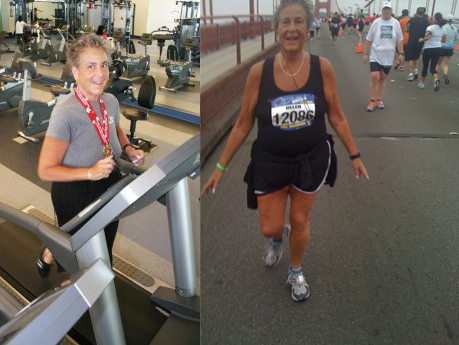CHAPTER 7
Alternative Routes to Sanity and Vanity
TREADMILLS, CROSS-COUNTRY SKIING MACHINES, WEIGHT TRAINING, AND FITNESS CENTERS
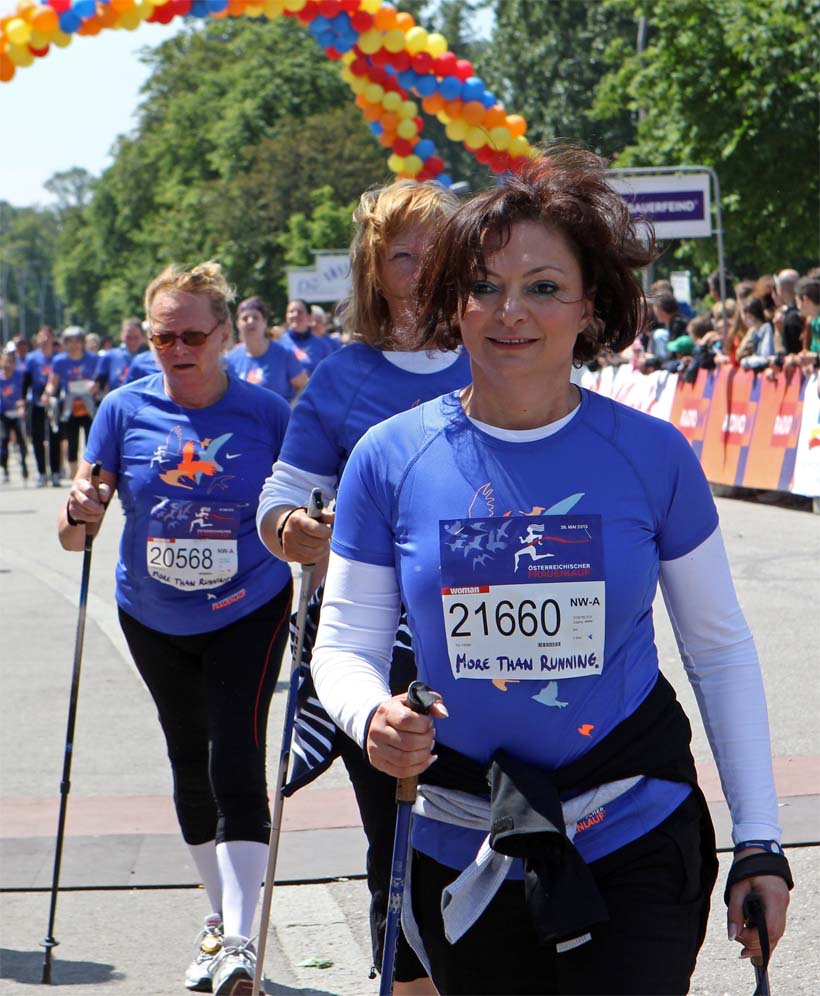
If you had a dollar for every woman whose running or walking program foundered because of the competing demands for her time, you’d be rich enough to afford the most expensive personal trainer to keep you fit. But for most of us, the reality of too many things to do and too little time to do them needs to be handled on a more practical basis. When you’ve exhausted all the time management techniques and still can’t find the time to run or walk regularly, the answer may come down to choosing among exercise alternatives.
Your own treadmill or cross-country training machine, weights, a gym, or even a personal trainer to work with you at home or at your gym may offer the flexibility you need to keep your training on schedule, no matter what time constraints you have—and without feeling any guilt over missed runs or walks.
In addition, these alternatives can give variety and balance to your training. An occasional regimen of aerobic classes, swimming or aqua-jogging at your gym or local Y may be just the tonic to keep you fresh for running or walking. And if you’re injured, stationary bikes or swimming can keep your aerobic fitness level up until you recover enough to begin running or walking again.
Finally, most fitness experts now believe that you should try to incorporate balance in an exercise program to achieve total fitness and promote overall well-being. Different activities work different muscle groups to help you achieve maximum flexibility and aerobic capacity while minimizing the possibility of overuse injuries. Select complementary activities—combine running or walking with biking or swimming, for instance—and add strength training to build a program that will keep you fit and enthusiastic.
Let’s take a look at some of the best exercise alternatives.
Talking About Treadmills
|
A personal note The treadmill may be the saving of fitness for thousands of women. I’ve come to this conclusion after nearly fifty thousand beloved miles run in every possible kind of weather and a true hatred of indoor exercise. Treadmills are ugly, expensive, soulless machines that take up a lot of room. But, by heaven, they may be the answer for the truly time challenged and responsibility burdened among us. So if the treadmill fits your lifestyle best, don’t look for other answers. Besides, with something that ugly taking up so much of your precious living space, you’ll probably use it. |
Treadmills are staple pieces of equipment in some fitness centers and gyms, but here I’m talking about treadmills you purchase for home use. They can be the answer to many time challenges.
- THE TIME-STRAPPED WORKING WOMAN: For the working woman who needs to be in the office by 8.00 or 8.30, the treadmill can be a lifesaver. It saves you time in many ways. Instead of dressing for a run, you can roll out of bed and into your sneakers in whatever you wore for sleeping—that’s at least fifteen minutes saved right there. You can step off when you need to use the bathroom and not have to wait for nature to call before you go out; that’s probably five minutes anyway. Coiffured hair stays perfect without exposure to wind, rain, or hats, and you’re another twenty minutes ahead in hair-washing and blow-drying time. Watch the morning news on television while running or read the newspaper if you walk—twenty more minutes saved. A total of sixty minutes on the plus side of the ledger—perhaps the difference between exercising or not.
- THE MOTHER OR CAREGIVER WHO CAN’T LEAVE HOME TO EXERCISE: The treadmill enables you to exercise and still keep an eye on those in your care. Moreover, exercise is a great stress reliever, and people confined to a house need a break, even if they can’t go out for it.
- THE WOMAN WHOSE BUSINESS IS IN HER HOME: Can’t afford to miss an important Skype, fax, or overnight package? Run or walk on your treadmill and you don’t have to risk missing anything.
- THE WOMAN WHO CAN EXERCISE ONLY VERY EARLY IN THE MORNING OR VERY LATE AT NIGHT OR WHO LIVES IN A DANGEROUS NEIGHBOURHOOD: Exercising should always be a stress and tension reducer, so there is no point to exercising in conditions you feel are dangerous. Under any of these circumstances, a home treadmill always fits into your schedule and does so in the safety of your home.
- THE WOMAN WHO KNOWS SHE WON’T GO OUT TO EXERCISE ONCE SHE’S COME HOME AT NIGHT: Whether it’s dinner preparation, children, or simply a reluctance to change and go out again, you can easily accommodate exercise to your needs with a home treadmill.
Advantages and Disadvantages of Treadmill Walking or Running
Besides the convenience of an at-home workout, exercising indoors means you don’t have to contend with any adverse wind or weather conditions. By regulating the treadmill’s speed, you can maintain an exact pace. Or if you want to raise the intensity of your workout, you can increase the incline to make yourself work harder. The machine’s surface is also softer and more flexible than most outdoor running surfaces, so it’s gentler on your feet and legs.
|
A personal note Treadmills can put some punch into your workouts. Put yours on an incline so you are working uphill. Adjust the speed of an electric treadmill so you have to move faster. An intensive twenty-minute hill walk will be a lot more useful to you than a twenty-minute saunter. The treadmill can also keep challenging you. Many top athletes use treadmills to get additional work on hills and speed that they may not find outdoors. |
The chief disadvantages of a treadmill are cost, space, and monotony. Treadmills cost between $500 to $5,000, but you will probably need to spend $1,500 to get the features you want. Although this is a large outlay of money up-front, you need to weigh it against the treadmill’s potential usefulness in helping you maintain your running or walking program over an extended period of time. A good treadmill lasts for many years and yet it costs no more than most one-year gym memberships, so over time the high initial cost may turn out to be a real bargain.
Treadmills are large pieces of equipment, and if you live in a small apartment or house it may be out of the question, even if you get the type that folds up. Also, if you put it in the basement or garage to keep it out of sight, it may wind up being out of mind as well, giving you a good excuse to skip a workout.
One of the special joys of running and walking outdoors is the sights and sounds of people and nature you experience. A treadmill can’t match that, but it’s one piece of exercise equipment for which earphones are ideally suited. You can listen to music, the news, or books on tape (a friend has listened to all of Jane Austen and Charles Dickens on the treadmill). Or you can set up a television nearby to keep your mind occupied, or place the treadmill near a window or door so you can imagine yourself outside to relieve the tedium.
|
A personal note Ingrid Kristiansen, the former women’s world record holder in the marathon, had an intense rivalry with Joan Benoit (Samuelson), the Olympic gold medalist. During the height of their competition against each other, Ingrid, who lives in Norway, trained indoors on a treadmill during the winter facing a big poster of Joan. |
Setting Up an Exercise Routine for the Treadmill
To get the maximum benefit of running or walking on a treadmill, you need to establish the proper pace. You can easily adjust the speed of the treadmill and walk faster to keep up that pace, but if it is too fast for you, there is a risk of injury. Dr. Ayne Furman, who has seen an increase in treadmill-walking injuries, suggests that you establish a baseline pace by determining your running or walking pace on a track (as we described in Chapter 4) and then set the treadmill to that time. You can gradually increase the pace, just as you would for outdoor running or walking, but only as you feel yourself gaining strength and stamina. Don’t set the treadmill faster and strain to keep up with an unrealistic pace.
Cross-Country Skiing Machines
These machines simulate outdoor cross-country skiing, one of the best forms of aerobic exercise. The benefits of cross-country skiing and running and walking are very similar, and many well-known marathon runners, including nine-time New York City Marathon champion Grete Waitz, were former cross-country skiers.
The training advantages of using a cross-country skiing machine are similar to those of a treadmill, with the additional feature that it allows you to vigorously exercise your upper body. These machines are not powered by electricity. The training effect results from sliding your feet forward and back, while your hands also pull up and back, as if you were using poles in cross-country skiing. Once you become proficient with these machines, they provide an excellent overall workout with no impact on your feet and legs, so they are also good if you have any persistent injuries.
The most widely known and popular cross-country skiing machines are manufactured by NordicTrack. They cost around $700. They also make elliptical trainers and treadmills, which of course cost a lot more.
Cross-Trainers
Cross-trainers are machines that promote an elliptical movement which closely resembles a non-impact running movement. On some models, the in-built handles, which may also take your pulse, can be worked backwards and forwards independent of your legs. Alternatively, you can elect not to use the handles at all. Cross-trainers give you a great, low-impact workout, both standing up or sitting down. They are ideal if you are recovering from illness or an injury, as you are able to have an intense workout without all that pounding on your legs. Be careful, though; you can easily overdo things as your heart rate can rise rapidly. Some models have sophisticated training profiles for you to choose from, e.g. ‘hill’, ‘manual’, ‘x-train reverse’ (great for your hamstrings), and ‘cardio’, while others have more modest built-in programs. Gabrielle O’Rourke, long time New Zealand champion distance runner, frequently uses the cross-trainer and says that the greatest benefit is that runners can simulate running or walking sessions by relating effort to heart rate. For example, a long ‘run’ can be done by working at a steady state with your heart rate at about 120-140 beats per minute. There are great workouts for the arms if you want them, and you can isolate body areas to work on.
As with any other workout, you must warm up and cool down when you use machines. Try working out at your local fitness center before you commit to buying or renting one.
Weights and Weight Training
Weights are not an essential part of an effective running or walking program, but they can be an invaluable aid in your quest for overall physical fitness. Running or walking will transform your body, but weight training can speed up the process of reclaiming lost skin tone and elasticity, increase strength and flexibility, and build muscle—all keys to helping your body resist the tendency to gain fat as you age.
Research has shown that as you get older (the process may begin as early as age thirty), you begin to lose muscle mass. Rebuilding muscle mass is one way of speeding the rate of your metabolism, which leads to the burning of more calories during exercise and a reduction in the buildup of fat.
Finally, and perhaps most important for women over the age of forty, weight-training is a weight-bearing exercise, these are those that force the body to work the bones, and continues to the buildup and maintenance of bone mass, a further deterrent against osteoporosis.
No matter what your age, it’s not too late to start a weight training program. The following exercises are a basic weight-training program that you can do at home with a minimum of equipment—a couple of weights, a towel or mat for floor exercises—and gain excellent benefit.
Upper Arms—Biceps and Triceps
|
TIP Since you probably will start a weight program at home, it is unlikely you’ll have two dumbbells lying around. So you can start with two large cans of tomato juice! Gyms will have small dumbbells in every weight, but it’s not necessary to join a gym to weight train. Dumbbells are easier to handle and you can get your own inexpensively online, at K-mart or a sports warehouse kind of place. Three or five pounds weights are plenty heavy enough; our emphasis here is on doing many repetitions with light weights. |
Start with two-, three-, or five-pound weights depending on your strength level. Start with five repetitions and build up to ten or fifteen. Aim to do two to three sets (a ‘set’ is a group of repititions) for biceps and three sets for the triceps, with thirty seconds’ rest between each set. This will help those flabby bits under your upper arms. Tip: the slow lowering of the weight is as important as the lifting of it.
BICEPS CURL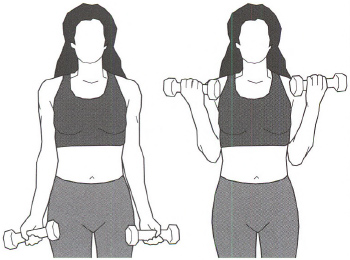 |
Stand with your feet hip width apart, back straight and knees slightly bent. Hold your arms straight down, next to your body, with your elbows close to your waist. Grip the weights in the palms of your hands, facing forward. Slowly raise the weights until they reach shoulder level, keeping your elbows close to your waist. Then slowly return to your original position. Don’t touch your shoulders or thighs with the weights. Inhale as you lower the weights, exhale as you raise them. |
BICEPS HAMMER CURL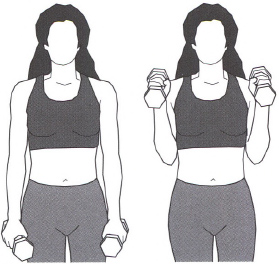 |
Stand with back straight, feet together, knees slightly bent, and stomach tucked in. This time hold your arms with the weights in your palms facing down. Slowly raise the weights to your shoulders. Then slowly bring arms down to starting position—do not touch your thighs. |
OVERHEAD TRICEPS EXTENSION, LYING DOWN |
Lie on the floor, with back flat, knees bent, feet on the floor. Extend arms and weights straight overhead with palms facing each other. Arms should be at a 90-degree angle to the floor. Keeping your elbows and upper part of your arms stationary, slowly lower your forearms to your ears. Slowly return forearms to their original position. Keep elbows in line with your shoulders throughout the exercise. |
TRICEPS KICKBACKS
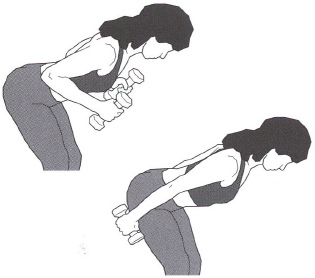 |
Stand with knees slightly bent. Bend at the waist, with your back straight to a forty-five-degree angle. Keep elbows bent, near to your body. Slowly extend your forearms backward, wrists stiff and upper arms quiet and in place. Slowly return arms to their original position. If you suffer from lower back pain, place one foot in front of the other to take some of the back strain, then proceed as usual. |
Legs and Buttocks
Lunges are terrific for working your thighs, buttocks, and hamstrings. For the novice, the biggest challenge can be keeping your balance. Take a big step forward. At first it probably will be easier to do, say, ten lunges with one foot, then ten with the other. When you become more accomplished, alternate right, left, right, left. Be sure to take the same size step with each leg, that way you will exercise each leg equally.
DUMBELL LUNGE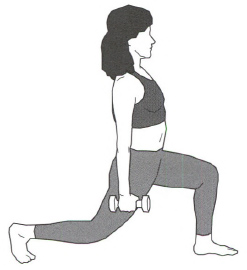 |
Stand with feet together, back straight, stomach muscles contracted, chest and shoulders high and relaxed. Hold dumbbells straight down at your sides, palms facing in. Step forward with your right leg until your thigh is almost parallel to the floor. Bend your lower rear knee but don’t hit floor. Return to starting position and repeat. Form is important to this exercise, so try it without weights until you are comfortable. Toes should always point forward. Keep the knee of the forward leg above the ankle—not in front of it—during the lunge and hips from falling below the knee line. |
Arms, Shoulders, and Chest
Women hate push-ups because we are not naturally strong in the upper body. At first, they are hard. But the good news is that you see improvement very quickly. One day you can do two push-ups; two days later you can do five. After a month you perhaps can do twenty. This is very heartening.
The traditional push-up is one of the best fundamental strengthening exercises. But for many beginners it may place too much strain on the lower back and neck, so start by trying the modified push-up suggested here. It does the same job—and eventually you can try the full push-up. Begin with two sets of three, then increase the number and sets. Tip: widen your hands to work your chest muscles more.
If you have problems with your wrists or elbows, you can do a variation. Lie on your back, with legs bent. With your upper arms straight out perpendicular to your body, and forearms pointing to the ceiling, raise hand weights until your arms are straight. Lower your arms to just above the floor (try not to rest your arms between reps). Repeat until you are really tired, as these aren’t as effective as actual push-ups.
TRADITIONAL PUSH-UP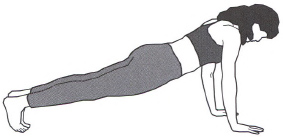 |
Lie with your body off the floor resting on toes and hands, arms straight and a shoulder width apart, fingertips forward. Slowly, lower your body straight down, without touching the floor, and then slowly push yourself up to the starting position. Keep back and buttocks flat. |
MODIFIED (BENT KNEE) PUSH-UP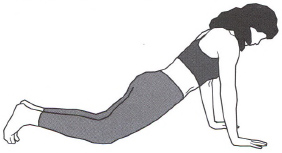 |
Kneel on hands and knees. Place hands shoulder width apart, fingertips facing forward, arms straight. Contract stomach. Lower your chest until you are just about to hit the floor, then push upward to your starting position. |
-
|
TIP If you can’t manage traditional exercises, start with these ‘negative’ versions. Sit-ups: lower yourself down from a sitting position, push yourself up with your hands, and repeat. Push-ups: lower yourself slowly to the floor, relax, roll over and start from the top again. |
Abdominals
These abdominal exercises strengthen your stomach muscles without straining your back. Do the abdominal curl first, then add the others to your workout. Start with five to ten repetitions and build up to two or three sets of thirty repetitions. Remember to keep your lower back flat on the floor during all of these exercises.
ABDOMINAL CURL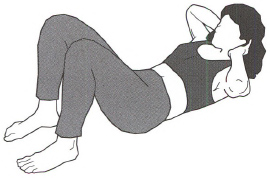 |
Lie on your back with knees bent, feet flat and fingers of hands just touching, at ear level, with elbows pointing out. (Don’t press hands to head.) Keep chin out; pretend you are holding an orange under it. As you exhale, curl up, bringing your shoulders off the floor. Keep your head still. Lower yourself to the floor, so that your shoulders touch, but the back of your head does not quite reach the floor. Repeat slowly. Tip: you are lifting yourself up by your abdominal muscles, don’t jerk upward with your head and shoulders. |
SHOULDER-KNEE AB CURL |
Start in the same position as for the abdominal curl. Use your abdominal muscles to raise yourself from the floor. Raise your feet up off the floor. Move your shoulders and knees toward each other. Your elbows should be pointing out, not forward—this avoids unnecessary strain on the neck. Remember, it’s your abs you’re exercising, not your neck. Once all repetitions have been completed, uncurl and then repeat. |
ALTERNATING SHOULDER-KNEE AB CURL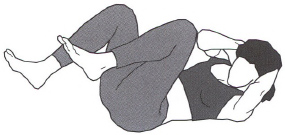 |
Use the same starting position for the shoulder-knee ab curl. With your shoulders raised off the floor, alternate moving your right shoulder towards your left knee and the left shoulder to the right knee. To get the most out of the exercise, move your knees straight forward and back, like riding a bicycle, and turn your body slightly from side to side to touch your knees. |
BACK EXTENSION |
Lie on your tummy with your head on one side, your legs comfortably apart and your arms down beside your body, palms up. Contract your lower back muscles and lift your torso up off the floor. Pause for 2 seconds and gently lower your torso to just above ground level. By keeping your tummy off the ground during each set, you will keep tension in your lower back. Keep your head to one side as this will prevent you from hyper extending your neck, which can lead to injury. Do one set of four to six repetitions on each side, twice (a total of four sets). |
Note: Always include at least one back exercise, otherwise you will end up with strong abdominal muscles and weak back muscles. This will predispose you to back injury.
-
|
A personal note I keep my dumbbells stashed under the sofa and use them while I am reading emails or watching the evening news. When I get more ambitious, I use free weights I have set up in the garage. I bought this set brand-new—bar, weights, props, and bench—at a garage sale for $75. Garage sales often have weight sets for sale because people buy with the best of intentions and then don’t use them. Just like gym memberships. Don’t make the same mistake. |
-
|
TIP Abdominal crunches are a real powerhouse for runners and walkers. Many back injuries are caused by weak abdominal muscles, a major area of concern for women over forty. Unfortunately, running and walking won’t strengthen your abs, so sit-ups are important. Not only do they help prevent injury but they flatten your tummy as well. |
The Amazing Wall Sit
This is my most valuable and magic exercise. It is a simple and quick way to prevent and recover from many knee injuries, because it builds up the quadriceps (thigh) muscles, and those strong muscles help keep kneecaps in place. Running and walking are great for the backs of your legs, but don’t do much for the quads. Sorry to say, but you feel the ‘burn’ with this exercise very quickly!
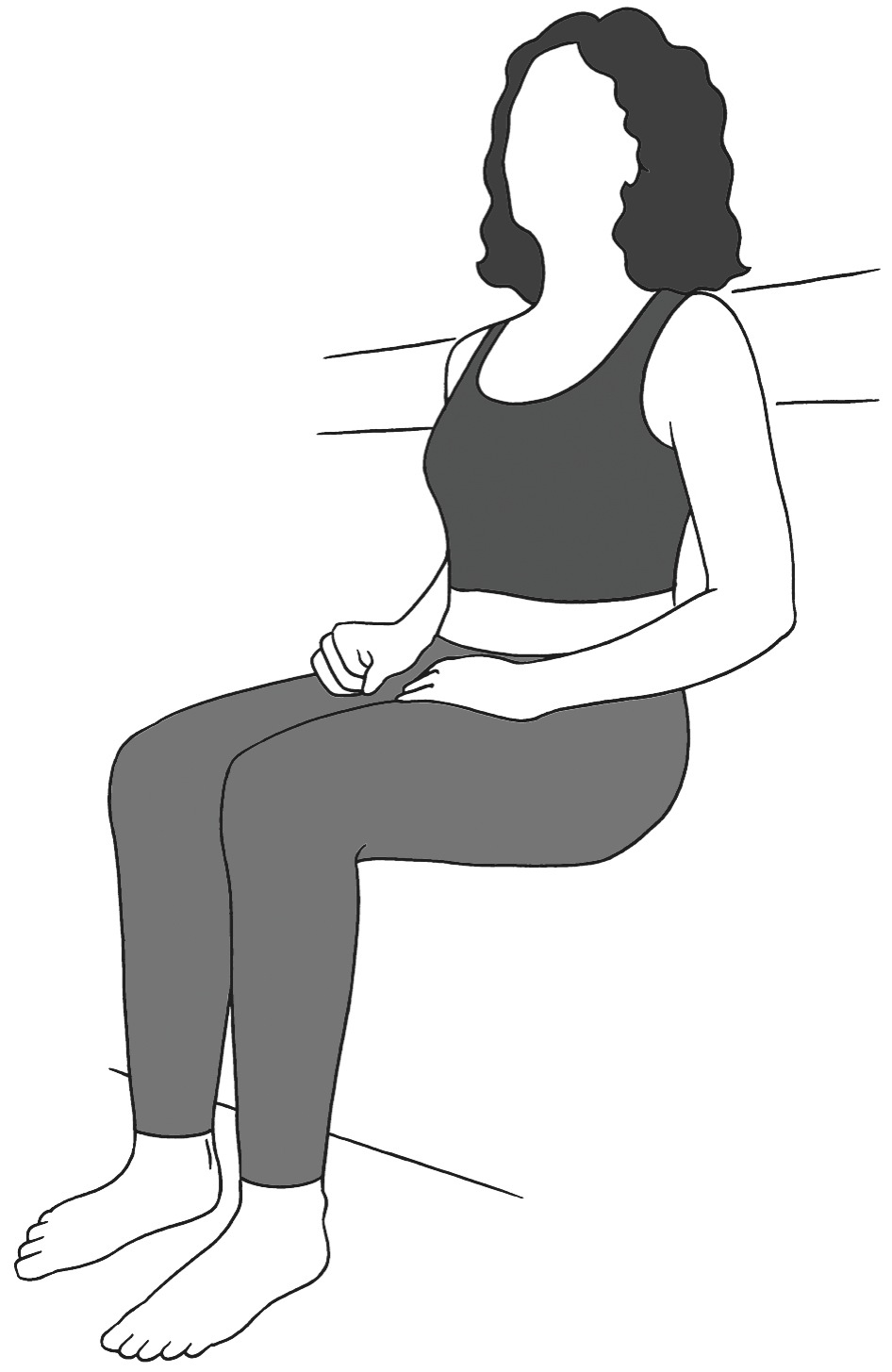 |
Stand with your back against a wall and slide down as if you are sitting against the wall, moving you feet out in front of you so that your thighs are parallel to the floor and your knees are at right angles. The back of your heels will be about eighteen inches from the wall. It will look as if you are sitting in a straight-backed chair, only there is no chair there. Keep you lower back pressed tightly into the wall. Just sit there and pretend it isn’t hard. Try for fifteen seconds every day for a week and build up by five more seconds each week. Note: Stand up before your legs give out and don’t slide down into a full squat. |
-
|
TIP It may be too difficult at first to sit with your legs at right angles, so you may need to sit a bit higher, with legs less bent for awhile. You’ll need to wear your sneakers or flat shoes that will grip the floor and not slide out in front of you. |
Fitness Centers and Gyms
For women under forty, physical fitness has emerged as a new standard of beauty to an unprecedented degree. The stars of the entertainment and fashion worlds are lean, with a sleek, well-toned look. They are working out, and younger women are following their lead. Nothing symbolizes this change more than the fitness center business. It’s booming as women use the clubs as multipurpose fitness and social centers.
Women over forty who have never been in a fitness center or health club might find the prospect intimidating, thinking they are full of buff men, lycra-clad sylphs of women and bizarre-looking equipment. That is absolutely not the case, as older women and men are finding a warm welcome in gyms and health clubs.
The fitness center is a great place to go to work out regularly or as an addition to a running or walking program—IF you use it. . They provide a variety of exercise alternatives—from treadmills and stationary bicycles to aerobic classes, pools, and weight-training equipment—and a fully equipped locker room for showering and dressing is open early in the morning and late at night. Many centers offer extras such as sauna, massage, a snack and juice bar, and child care. Men and women use the center as a social gathering place, where you can meet friends for a class or just enjoy working out in a social atmosphere. If you are ‘retired’, the gym can be especially good since you can use it at its most uncrowded time—unusually during the 9-5 work day, and get plenty of attention from the trainers and not have to wait for any equipment. Many gyms have special age-group classes during these hours just for you.
As wonderful as a fitness center membership can be, it does come at a price measured financially and in terms of convenience. Remember this disturbing statistic: two-thirds of people who join fitness centers never come back. Before joining one, you have to ask yourself what you really want from it and what you can actually expect to receive. And then use it!
Fitness Center Checklist
- Gym memberships are expensive, and most people think they’ve purchased fitness when they join. In truth, they have bought only the facility in which to work on fitness.
- Exercising in a fitness center may actually be more time-consuming than doing it on your own. Unless you can stop in directly on your way to or home from work, you must factor in at least thirty minutes to your workout to account for travel time to the center, changing, showering, and going back home. Since lack of time is the single biggest barrier to a woman maintaining an exercise program, this extra time can mean the difference between working out or not. In thirty minutes you can complete a great workout at your house and trotting around you neighborhood. If you decide to join, get the most convenient one possible.
- Fitness centers have a tendency to be most crowded just when you want to be there. Waiting for a piece of equipment wastes time and may eventually deter you from going at all. Try using waiting time to keep stretching or doing exercises not needing equipment; or schedule some workouts before or after peak periods.
- While some women like having other people around them when they exercise, others like privacy during a workout. It is a time for yourself and you don’t want to feel self-conscious about your jiggling thighs, lack of make-up or sloppy-by-choice gym clothes. It’s not possible to be totally anonymous in a fitness center, but the truth is that no one really cares. However, if you think people are looking at you and that makes you uncomfortable, a fitness center may not be for you.
- If you’ve never gone to a gym before, take advantage of the trial memberships most gyms offer. Use it for a week and see if you like the experience. Also, try to get a friend to join with you. The two of you can go for workouts together until you’re ready to go it alone. Or, who knows? Maybe your group will become regulars.
- Personal trainers are also available at fitness centers. They work with you until you feel comfortable with the center and its equipment and, for a fee, can become your personal instructor and help you stay motivated until you can do it for yourself. These trainers are invaluable, knowledgeable and highly inspiring. They may be the friend and training buddy you always needed and wanted.
